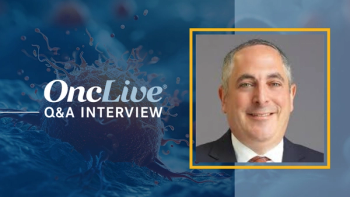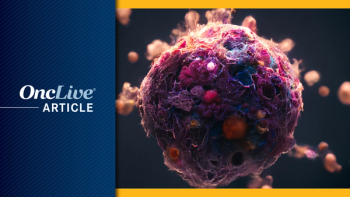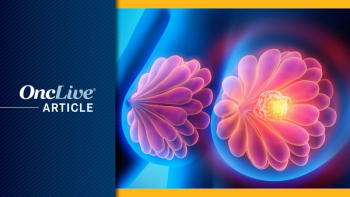
Biomarkers Require Refining in Lung Cancer Paradigm

Hossein Borghaei, DO, discusses pivotal and ongoing trials driven by biomarkers in lung cancer.
Hossein Borghaei, DO, MS
Upfront genomic testing has become the standard of care upon a non—small cell lung cancer (NSCLC) diagnosis. Now, researchers must work on finding and determining what biomarkers, beyond PD-L1, are best predictive of response to immunotherapy, explained Hossein Borghaei, DO, MS.
Recent studies have demonstrated the effects of immunotherapy alone and in combination with chemotherapy. For example, the KEYNOTE-024 trial explored chemotherapy versus pembrolizumab (Keytruda) in previously untreated patients with advanced NSCLC with PD-L1 expression ≥50%. In an updated analysis of the study, the median overall survival (OS) was 30.0 months for pembrolizumab versus 14.2 months in the chemotherapy group (HR, 0.63; 95% CI, 0.47-0.86).1 Based on earlier data from this study, the FDA approved pembrolizumab in 2016, for the frontline treatment of patients with metastatic NSCLC whose tumors have ≥50% PD-L1 expression.
The phase III KEYNOTE-189 trial examined frontline chemotherapy combined with pembrolizumab in patients with metastatic nonsquamous NSCLC without EGFR or ALK alterations. At a median follow-up of 18.7 months, updated results showed that patients in the pembrolizumab/chemotherapy arm had a median OS of 22.0 months versus 10.7 months for those who received placebo/chemotherapy (HR, 0.56; 95% CI, 0.45-0.70; P <.00001).2 In August 2018, the
"Right now, chemotherapy plus immuno-oncology is the standard of care, until subsequent studies show us other potential options for our patients. Eventually, we will decide how and when to use these better options," said Borghaei, the chief of the Division of Thoracic Medical Oncology, professor in the Department of Hematology/Oncology, and co-director of the Immune Monitoring Facility at Fox Chase Cancer Center.
In an interview during the 2019 OncLive State of the Science Summit™ on Non—Small Cell Lung Cancer, Borghaei discussed pivotal and ongoing trials driven by biomarkers in lung cancer.
OncLive: What is the utility of PD-L1 as a biomarker in clinical practice?
Borghaei: The biggest application for clinical practice is that the combination of chemotherapy plus immunotherapy for patients who have PD-L1 expression <50% is the standard of care, regardless of histology. We now have multiple phase III studies all looking at different platinum-doublet backbones, with different checkpoint inhibitors showing clinical efficacy. The majority of the studies that have been presented showed that for patients with PD-L1 expression <50%, it's a very reasonable option to offer them chemotherapy plus one of the checkpoint inhibitors.
For patients with PD-L1 expression ≥50%, chemotherapy plus immunotherapy can be useful. If fact, for patients who have significant disease burden, that probably is the treatment of choice. However, there is a possibility of using pembrolizumab alone in someone with PD-L1 >50% based on the KEYNOTE-024 study that shows clinical efficacy over and above platinum doublets alone. We don't have a head-to-head comparison in the PD-L1 >50% patient population of pembrolizumab versus chemotherapy/pembrolizumab, but those data may become available from other studies.
How do you navigate between the immunotherapy/chemotherapy regimens that were explored in the KEYNOTE-189 and IMpower150 trials?
KEYNOTE-189 compared chemotherapy alone with chemotherapy plus pembrolizumab in nonsquamous disease. In that study, regardless of PD-L1 levels, the combination of chemotherapy [plus pembrolizumab] was superior to chemotherapy alone. That became the standard of care for [patients with] nonsquamous histology. I would have a discussion with the patient in terms of some potential toxicities that one can anticipate from a platinum doublet. The decision-making process is a discussion with the patients to go through the pros and cons on whether they want to undergo chemotherapy or not.
I feel very comfortable offering pembrolizumab alone to the majority of my patients who have PD-L1 expression ≥50%. However, as I said, my one clinical criterion is that I need a rapid or a deeper response in terms of tumor shrinkage. Other than that, pembrolizumab alone can be quite effective. The case is the same whether we're looking at squamous versus nonsquamous histology.
The interesting patient population that we have to face is the patients who have molecular markers, such as EGFR or ALK. In that patient population, the data are a little less clear. The data that we have from the IMpower150 trial suggests that, in a very small patient population, the quadruplet regimen of carboplatin, paclitaxel, bevacizumab (Avastin), and atezolizumab (Tecentriq) can be very effective in terms of improving survival, and suggests that there might be some sort of interaction between VEGF inhibition and immunotherapy. IMpower150 showed that for this patient population, a 4-drug therapy could be a good option.
For the squamous cell histology, physicians can consider giving a combination of either carboplatin/nab-paclitaxel (Abraxane) or paclitaxel with pembrolizumab, or carboplatin/nab-paclitaxel with atezolizumab. In these studies, there does not appear to be an increase in immune-related adverse events (AEs], which is very reassuring. Otherwise, it would have been difficult to manage. When you compare a 3-drug regimen to a single drug or a doublet regimen, you have a little more toxicity. However, the [serious cases of] pneumonitis, colitis, and other AEs do not appear to be higher if you add chemotherapy to it, but the clinical benefit is there.
What are some additional unanswered questions within the lung cancer field?
Some of the unanswered questions are regarding better biomarkers. PD-L1 is a reasonable biomarker at this point. In recent years, we've started to look at tumor mutational burden (TMB) as a potential biomarker. We're still lacking prospective studies or real randomized prospective studies with TMB, and we still don't know the cutoff or methodology for using TMB.
The other unanswered question surrounds immune-oncology combinations [without chemotherapy]. Recent studies, such as MYSTIC, CheckMate-227, and NEPTUNE are going to be reported soon. Some of them, such as CheckMate-227, have some preliminary progression-free survival reporting. We are waiting to finalize all of these studies because they all look at the novel immune-oncology combination without the use of chemotherapy and also potentially look at TMB.
There is a possibility of receiving false negative or positive results from PD-L1 testing. Is repeat testing warranted?
We've known about [tumor heterogeneity] in lung cancer for a long time. There is no evidence that repeat biopsies are going to change things. One has to keep in mind that biopsies are not simple, especially in patients with lung cancer. Every time you subject an individual to a biopsy, especially if it's a lung lesion, you're putting the patient at risk for some toxicities.
At some point, you have to decide that it's not acceptable to put the patient at risk. I'm not in favor of performing a re-biopsy just to get another immunohistochemistry done. If we don't get enough tissue at the time of initial diagnosis, we must obtain a second biopsy to get adequate tissue; however, if we get enough tissue and the tumor is PD-L1 negative, I'm not in the habit of repeating the biopsy and checking it again.
Could you expand on the use of biomarkers in the lung cancer field?
We, as clinicians, feel that we need a better way of figuring out which of our patients are going to benefit from immunotherapy. As well tolerated as they are, they still carry some potential AEs that are risky for some patients. Additionally, the drugs are expensive. If we can avoid giving the drugs to everybody, there are multiple benefits downstream from it.
Having appropriate biomarkers are important, but it might not be a single marker, which is what we typically think. It might be a combination of different things or a multiplex of various tests that are available out there. We are trying to identify patients who would draw the most benefit from the newer tools and drugs that we have available.
I've presented some [data] in terms of identifying what is happening at the tumor microenvironment. The challenge is making this available so that everyone can benefit from [genomic testing] sooner and avoid having to wait 6 to 8 weeks to know what kind of treatment we are going to offer them. I am very hopeful that within the next 2 to 5 years, we'll find the appropriate biomarkers for immunotherapy.
What ongoing research is focusing on the utility of TMB?
In CheckMate-227, TMB was introduced before the final data was analyzed, so in some ways it was a prospective study. There might be another study being reported soon where a similar strategy was taken. The problem is that we haven't selected how to best measure TMB and an appropriate cutoff. We still need to do a little bit of work before we go into a very large phase III, randomized, prospectively designed study with some degree of confidence.
How can we shorten the waiting period for patients who have received genomic testing?
That is part of the $10 million question that everyone is asking. What is a biomarker? What kind of tissue are you going to use? Is it blood based or tissue based? How much of everything do you need? How fast can you get it done? In the world of EGFR, ALK, and other mutational analysis, we have decided that patients shouldn't wait any more than 2 weeks for genomic data. There are some guidelines published to that effect. I am confident that once we decide on a biomarker, we can get it there.
References
- Reck M, PhD1; Rodríguez—Abreu D, Robinson AG, et al. Updated analysis of KEYNOTE-024: pembrolizumab versus platinum-based chemotherapy for advanced non–small-cell lung cancer with PD-L1 tumor proportion score of 50% or greater. J Clin Oncol. 2019;37: 537-546. doi: 10.1200/JCO.18.00149.
- Gadgeel SM, Garassino MC, Esteban E, et al. KEYNOTE-189: Updated OS and progression after the next line of therapy (PFS2) with pembrolizumab (pembro) plus chemo with pemetrexed and platinum vs placebo plus chemo for metastatic nonsquamous NSCLC. J Clin Oncol. 2019;37(suppl; abstr 9013). doi: 10.1200/JCO.2019.37.15_suppl.9013.

























































































